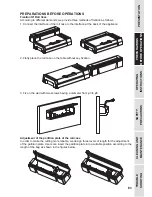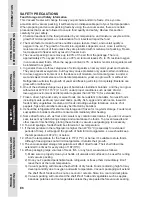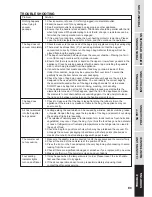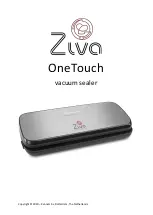
E5
PRESENTATION
PREPARATIONS
BEFORE OPERATIONS
OPERATING
INSTRUCTIONS
SAFETY
PRECAUTIONS
CLEANING AND MAINTENANCE
TROUBLE SHOOTING
Vacuum packaging in Canister & Vacuum Bowl
1. Close the lid of the vacuum sealer and shut the lock handle down
2. Pull out the retractable hose of the vacuum sealer to the desired length (Max. 60cm/23’’),
and insert the hose end into the interface of the interface of the canister (See Fig 7)
3. Press the Canister button to start vacuumizing for the canister and it’ll stop until all vacuum
indicator lights turn off
4. After the vacuumization is completed, remove the hose from the canister
5. Pull out the hose to 30mm long and then loosen it, it can retract automatically
Tips for Vacuum Sealing
1. Vacuum sealing is NOT a substitute for the heat process of canning. Perishables sti1l need
to be refrigerated or frozen.
2. Do not overfill the vacuum bag. Leave enough empty space in the open end of the bag so
that the bag can be placed in the vacuum channel without creating wrinkles or ripples.
3. Clean and straighten the open end of the bag before sealing. Make sure nothing is left in the
open area of the bag, no wrinkles or creased lines should appear in the open panel, foreign
objects or creased bag may make it difficult to seal tightly.
4. Do not leave too much air inside the bag, Press the bag to allow extra air to escape from the
bag before vacuum. Too much air inside the bag will increase the vacuum pump loading and
may lead to insufficient power of the motor to draw away all the air inside the bag.
5. Do not apply vacuum packaging for objects with sharp points like fish bones and hard shells!
Sharp points may penetrate and tear the bag! Use a container or a vacuum canister instead
of a bag to store such objects.
6. Make sure there is no crack or deformation, or small particles leaving in the foam gaskets
around the vacuum chamber. Otherwise, take it out, wash and dry it thoroughly, or replace
with a new one.
7. During the vacuum packaging process, small amounts of liquids, crumbs or food particles
can be inadvertently brought into the vacuum chamber, which may clog the pump and
damage your appliance. To avoid this, freeze moist and juicy foods first before sealing bags
or place a folded paper towel near the inside top of the bag. For powdery or fine-grained
foods, avoid overfilling bags. You may also place a coffee filter inside before vacuum
packaging.
8. Pre-freeze fruits and blanch vegetables before vacuum packaging for best results.
9. Liquids need to be frozen before vacuum packing.
10. Store perishable foods in the freezer or refrigerator. Vacuum packing extends the shelf life
of foods, but does not preserve them.
11. To avoid overfilling, always pull out bag material at least 8 cm (3 inches) longer than the
desired length.
12. When using accessories, remember to leave 2.5 cm (1 inch) at the top of canister or
container.
13. Pantry items such as flour, rice, and mixture for cakes and pancakes, all can stay fresher
longer when vacuum packed. Nuts and condiments can maintain their flavor.
Note: After use, please always leave the lid of the vacuum sealer open and don't fasten
it. Otherwise, it will deform the form gaskets and affect the functions.
Fig. 7






























